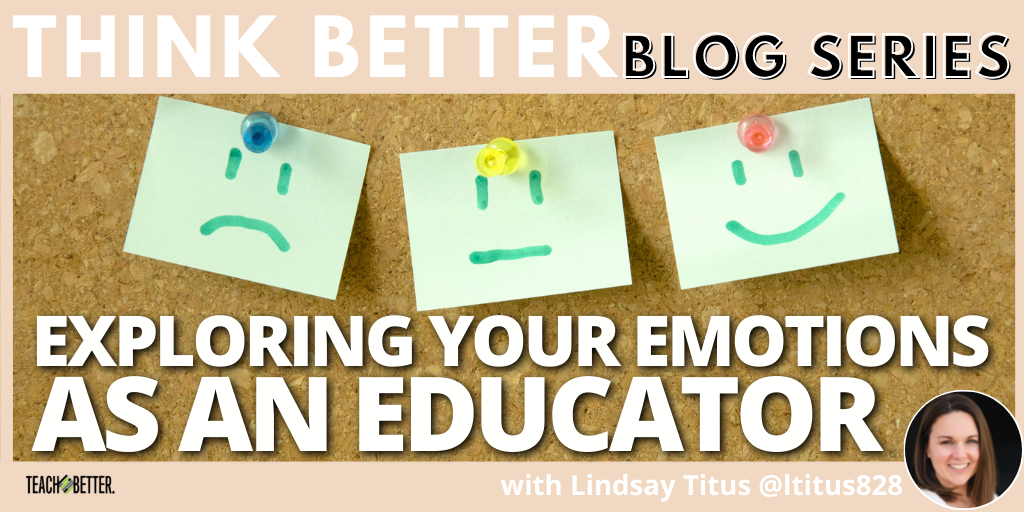TL;DR:
- Are you aware of the emotions present within your classroom environment?
- Educators are taught to focus on action rather than on feeling the emotions below the surface.
- The core emotions are fear, anger, sadness, shame, jealousy, disgust, happiness, and love.
- Identify and unpack emotions so you can take care of yourself.
- Instead of putting “I am” before a feeling word, try saying something like “I am noticing that I’m feeling anger.”
Emotions in the Classroom
As a self-contained special education teacher, I was very aware of the emotions that existed in my classroom during the day. However, reflecting back, I don’t know that I used this information to my advantage. Throughout the day, while teaching the core subjects of reading, math, science, social studies, and writing, emotions were often high. Although thinking back, while I was teaching, I didn’t think of emotions being high. I always referred to behaviors being high.
The challenge with this mindset is that I constantly focused on the actions of the student. The observable actions dictated my responses. And, the challenge here is that by doing this, I forgot about what was lying underneath the behavior. I wasn’t giving time, attention, compassion, or energy to the thoughts and feelings fueling the behaviors I was seeing.
Thinking of emotions as energy in motion helps to remind me that emotions are purposeful. Emotions help connect the dots that are often invisible to the eye. They create awareness in a sea of uncertainty. Click To TweetReleasing from Society’s Desires
When I stop and reflect on why it was more natural for me as an educator to focus on the actions over the emotions, it didn’t take very long for me to come up with an answer. It’s what we are taught to do. We, as human beings, are conditioned to focus on doing, over honoring the emotions underneath the surface. As a result, for the past 16 years, I have dedicated much of my own personal and professional development to better understanding the emotions within me and how these emotions drive the actions I take each and every day, in and out of the classroom.
Monumental Impact
The work we do as educators is monumental. What other profession gets to impact the future in the present moments of today? What other career path provides you the opportunity to empower students to inquire, remain curious, and ignite transformative change? With those opportunities, emotions are present. Many emotions are present. In her book, Onward, Elena Augilar breaks down emotions into eight core emotions. The core emotions are fear, anger, sadness, shame, jealousy, disgust, happiness, and love. Within each of those categories are 20+ more emotions. That’s a lot of emotions!
Educator Resilience
The high level of emotions we face in a day is what makes this work so crucial to your own resilience as an educator! Emotions will be present. They come from our students, staff, families, and ourselves! It is so important to remember that they are energy. Thinking of emotions as energy in motion helps to remind me that emotions are purposeful. Emotions help connect the dots that are often invisible to the eye. They create awareness in a sea of uncertainty. As soon as my emotions shift from a feeling of belonging to a feeling of being neglected, I know it’s time for some inner work. It’s time to unpack the shift and learn to identify the truth behind the trigger.
Spending Time with the Emotions You Feel
Emotional changes will happen, yet it is important to remember that you are not your emotions. Exploring your emotions as an educator isn’t about finding the right emotion or eliminating the wrong emotion. As Susan David tells us, “emotions are data, not directives.” Learning to identify the emotion, unpack its strength, and expand the story, we are able to discover the truth behind what is triggering us, while remaining open and accepting to the situations we find ourselves in. Give yourself time and space to listen to your emotions without judgment. Use reflective tools such as meditation or journaling to become more aware and accept the emotions you are feeling.
[scroll down to keep reading]Educator Emotions: Reframing Activity
Exploring our emotions is not a one-day activity. It’s an everyday opportunity. By learning how to become aware of our emotions and not allowing the emotions to define who we are, we are able to remain present, calm, and accepting of the lessons we are learning each day. As this blog series is “think better,” the reframing thought I’d love for you to leave with today is this:
You are not your emotions!
You are you and that, my friends, is a powerful statement.
One simple reframe to put this into practice today: Instead of using the words “I am” before an emotion like “I am angry,” instead use “I am noticing that I’m feeling anger.”
Mindset change happens with small, simple, and strategic steps and this is one reframe that you can start using today!
Today, and every day, honor who YOU are from the inside out. Listen to your emotions. Really listen to them. And always remember that they are simple energy in motion and so when it is time, release them, and honor the love and compassion YOU have for the educator that YOU are!
About Lindsay Titus
Lindsay Titus is a K-12 Behavior Specialist with a license in behavior analyst. As a Board Certified Behavior Analyst, Lindsay coaches and trains educators on the study of behavior and how to implement evidence based behavior principles in simple and easy ways! With experience as a classroom special education teacher, and behavior specialist in public schools, residential placement, and private settings, Lindsay enjoys working with all educators looking to reignite their passion for education, connect with all students, and conquer challenging behavior in any classroom setting.




